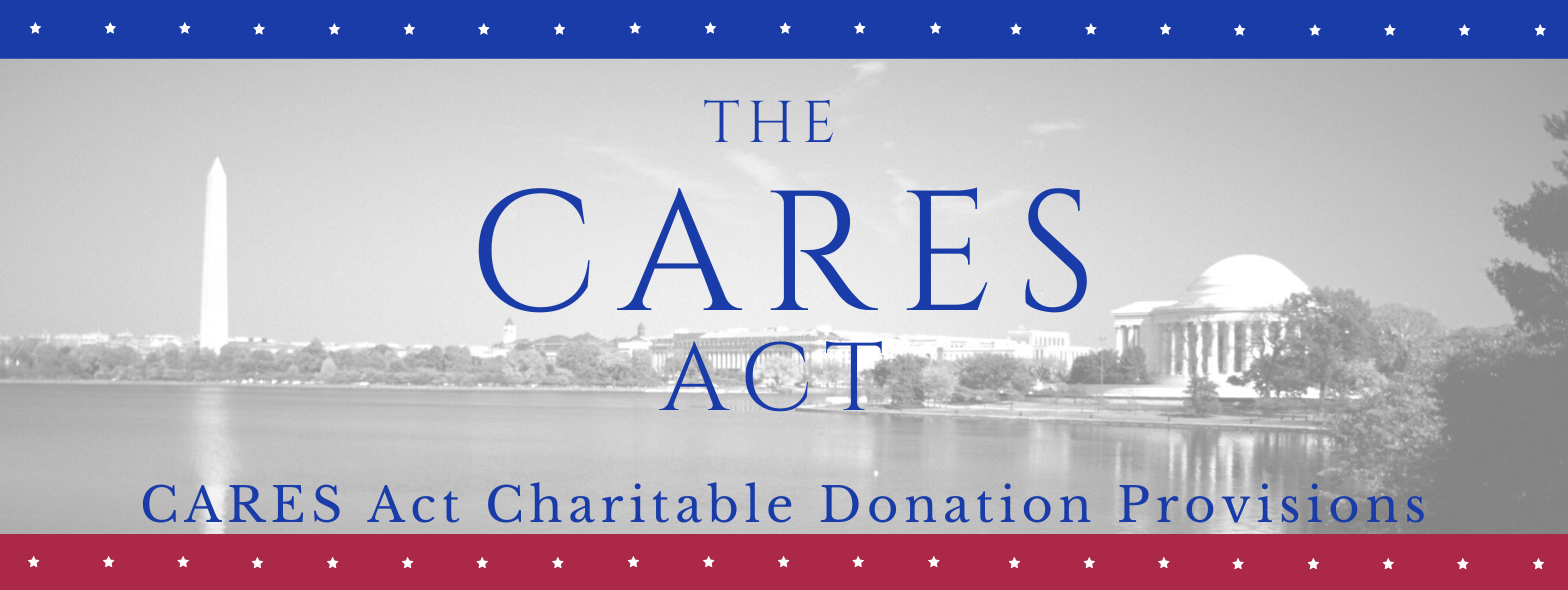Are you US citizen? Find out even more ways to give via the CARES Act and IRA Charitable Contributions.
CARES Act Charitable Donation Provisions (US only)
The charitable donation provisions of the CARES Act have been extended into 2021, with some improvements.
Did you know?
- Even if you do not itemize deductions on your federal taxes, you can deduct up to $300 of charitable gifts made in 2021, up to $600 if you file jointly.
-
- If you do itemize deductions, you can deduct up to 100% of your Adjusted Gross Income (AGI) for charitable gifts made in 2021.
- If you are at least 59½, you may take a distribution of any amount from your IRA or 401(k), give the same amount to a qualified charity, and avoid paying any federal income taxes on the distribution.
These provisions and more are included in the CARES Act II by the US Congress in December 2020 in hopes that it will stimulate charitable giving in 2021. So far, these have not been made permanent provisions, so this applies only to gifts made in 2021. You must act by December 31, 2021 to take advantage of these temporary changes.
What does this mean for you?
If you do not fill out schedule A on your federal income tax forms, you can get a deduction as if you did for gifts totaling up to $300, up to $600 for joint returns, to qualified charities like the RREACH. The ability to deduct $600 on joint returns is new for 2021.
If you do fill out schedule A, you may now deduct up to 100% of your AGI for gifts made to qualified charities. This deduction allowance is the same as 2020, but an increase from 60% in previous years. Qualified charities include public charities and churches, but do not include private foundations, supporting organizations, or donor advised funds, commonly called giving funds. As a public charity, RREACH is a qualified charity.
Should you decide to give more than 100% of your AGI in 2021, you may carry forward the deduction for up to five years.
If you are at least 70½ years old, you already had the benefit of making an IRA charitable rollover contribution up to $100,000 as a satisfaction of your required minimum distribution. That rule was not changed by the CARES Act or CARES Act II.
But if you are between 59½ and 70½, CARES Act II allows you take a distribution from your IRA or 401(k), contribute the same amount to a qualified charity, and take a deduction of 100% of the gift on your federal taxes. An IRA or 401(k) distribution is taxed as ordinary income. So if you take a distribution of $50,000, that could put you in a higher income tax bracket and significantly increase your federal tax. But if you give the $50,000 to one or more qualified charities, you can take a deduction of 100% of it, preventing a higher tax bracket and totally offsetting taxes on the distribution.
Corporations are also being encouraged to give by CARES Act II. Corporations can now deduct up to 25% of their taxable income for gifts made to qualified charities in 2021, an increase from 10% in years before 2020.
Several important things to keep in mind when making your giving decisions:
- The CARES Act II provisions apply only to federal taxes. Most states have not changed their rules regarding charitable contributions. Therefore, your deduction allowance for a charitable gift will be a lower percentage and you may owe state income tax on any IRA or 401(k) distribution.
- Remember that there is a difference between a tax credit and a tax deduction. A tax credit directly reduces the tax you owe. A tax deduction reduces the amount of income that is taxed. CARES Act II provisions have to do with deductions, not credits.
- This summary refers to cash gifts only. CARES Act II does not change the rules for making non-cash gifts, such as stock, real estate, or other property.
- Every situation is different. For example, you may not be able to take advantage of CARES Act II provisions because of the Alternative Minimum Tax (AMT) and other income tax regulations. Always check with your tax advisor before making a large gift.
- Finally, CARES Act II applies only to 2021 charitable gifts. These provisions will likely not be extended.
To learn more, check with your tax adviser. This educational illustration is not professional tax or legal advice.
IRA Charitable Contributions
An individual aged 70½ or older with an Individual Retirement Account (IRA) may contribute up to $100,000 total annual from that account to a qualified nonprofit ministry such as RREACH.
Why might this be beneficial to the individual?
- Starting at 70½, individuals must begin taking distributions from their IRAs, which could put them in a significantly higher tax bracket. A Charitable Contribution reduces the required distribution by the amount of the gift, avoiding higher income and possibly higher taxes.
- If an individual takes the distribution as taxable income and then donates the same amount to a ministry, the amount they can deduct from taxes will be limited to 60% of their adjusted gross income (AGI), which is now higher because of the IRA distribution, potentially causing a high tax bill. Even though the remaining gift deduction can be carried over to future years, the deduction will likely not be as valuable.
- If an individual takes the distribution as taxable income, the increased AGI will also increase the amount of medical and miscellaneous expenses that cannot be deducted from taxes because of the percentage of AGI floor on these types of expenses.
What are the requirements for making an IRA Charitable Contribution?
- The IRA owner must be 70½ or older.
- The contribution must be made from a traditional IRA or Roth IRA (though it probably won’t be beneficial to contribute from the latter).
- The contribution must be made directly from the IRA to the ministry. It cannot be distributed to the IRA owner first.
- The contribution must be made to a qualified charity. Most nonprofit ministries qualify. But contributions cannot be made to private foundations, donor advised funds, or supporting organizations. RREACH qualifies.
- Both husband and wife can donate up to $100,000 from each of their IRAs each year, or a total maximum of $200,000.
Keep in mind that since you are not receiving the distribution as income, this contribution from your IRA is not a tax deductible gift.
To learn more, check with your tax adviser. This educational illustration is not professional tax or legal advice.




